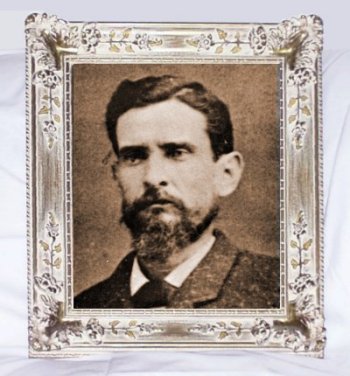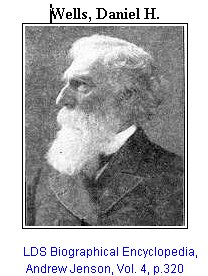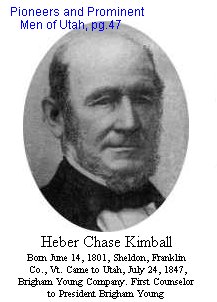|
THE LIFE SKETCH OF GEORGE WILCOX BURRIDGE (Part 9 1866 - 1867 Patriarchal blessings, Mission call and departure) Written by his grand-daughter, Ann M. Neddo
|
|||||
|
Part 1 1805 - 1831 Youth Part 2 1831 - 1847 Army Part 3 1847 Courtship & Marriage Part 4 1847 - 1852 Marriage, Baptism and the End of a Career Part 5 1853 - 1855 Isle of Malta mission Part 6 1855 - Going to Zion Part 7 1855 - 1857 Hard times Part 8 1857 - 1860 (?) Johnson's army and back to Rush Valley Part 9 1866 - 1867 Patriarchal blessings, Mission call and departure Part 10 1867 Journey to the British mission Part 11 1867 - Mission Part 12 1868 - Mission Part 13 1868 - Return Home Part 14 1868 - 1888 Bishop, Storekeeper, and Iindians - oh my Part 15 As seen by others Part 16 1880 -1888 The culmination of a lifetime Part 17 1888 -1891 Patriarch and Death Part 18 Miscellaneous |
On April 9, 1867, he was excited and filled with happiness and gratitude when he was called to Great Salt Lake City and in the presence of the revered leader President Brigham Young, was told by Elder George Q. Cannon to prepare for and to go back to his Mother Country, England, on a mission. His faith never faltered. Although he was not financially ready he hesitated not at all but immediately accepted the assignment. Consternation mingled with joy and tears as preparations were made for this wonderful opportunity to help spread the Gospel. Despair had its moments when thoughts of the long separation were allowed to enter with fears of how they were to live day by day. Just sixteen short days and he again went to Salt Lake taking Hannah, their daughter, Charlotte, son, Thomas Lorenzo and Mother Shaw, (which was what he always called Hannah's mother) with him. April 30, 1866 found the family assembled in the Patriarch's office where both he and Hannah had their Patriarchal Blessings from C. B. Hyde. On May 6, 1867, he met with Presidents Heber C. Kimball and Daniel H. Wells to be blessed and set apart under their hands for a mission to the nations of the earth.
With the sun gilting the tops of the mighty mountains with pink and flushing the eastern sky with the glory of dawn carrying promise of a clear day George on May 18, 1867 bid his precious family good-bye. After final words of concern and instruction concerning their welfare he started with David P. Kimball's mules train in the same wagon with Henry I. Moore and Arne Christiansen on his way to the frontier of the United States. In spite of the beauty of the day this proved to be an unexpectedly eventful day. They traveled smartly along, beginning to get the feel of becoming a group of people destined to survive the peril and hardships of this wilderness trail for many days together. The canyon was still shrouded with the remains of winter snows and the ground had not taken on its summer dryness but was spongy and wet. After about one mile of climbing up Emigration Canyon the wagon, in which George's clothes and provisions for his survival were packed securely for the journey was very near the edge of the narrow, slippery dug-way when the road dropped from beneath the wheels causing the wagon to tip and plunge to the creek below. George began a hurried slipping and sliding after the plunging wagon but dismay filled him as he watched his badly needed and carefully prepared clothing caught up by the rapid stream and whirled away as his chest crashed against the rocks of the stream, then his revolver belt and ammunition pouch together with his shoes were tumbled and rolled in water too swift and deep and cold for man to attempt their rescue. The water did a thorough job of soaking the flour, meat and other provisions. All that could not stand the wet were destroyed. The books, letters and papers which were packed securely in his carpet bag were well soaked and damaged. After sorting and spreading them out to dry some were saved. His precious rifle was picked up, dried and cleaned. With the help of ropes and manpower and after hours of hard labor the wagon was raised from the creek and camp was made for the night. The next morning was dark and foreboding - no promise of a fair day heralded the dawn. Then came one of those surprise storms when spring and winter battle and rain and snow falls. It kept this up until about noon. David P. Kimball took George into his wagon while the storm raged. About noon on the 19th of May he started back toward Salt Lake. Down along the creek searching all nooks and swirls for his lost possessions. Down by Sugar House Ward and near to Brigham Young's Mill in the big field but not a scrap or garment did he find. He carried in his pocket a letter to Heber C. Kimball written by his brother, David. This letter he took to Bro. Kimball at his home. After reading the letter George was welcomed into the Kimball home where he spent a comfortable night. The next morning Brother Kimball got up a subscription for him which supplied him once again with clothes, provisions, money and food and other useful and necessary articles. Loaded with these he returned to the wagon train, camped in the canyon. He reached the camp about two miles farther on at eleven o' clock at night. Tired and worn out yet thankful to find all well at camp. The thought of turning back and quitting never entered George's mind. In spite of the bows of the wagon being broken up and the wagon cover badly torn which meant facing hundreds of miles with no protection from the weather, he went on. The next night found them on the side of Little Mountain, about nine miles from Salt Lake City, not much distance being covered that day. The rain and snow had quit but it was bitter cold at those heights. Two days later they reached Kimball's Hotel in Parley's Park. [Editor's note - Kimball's Hotel was in the present town of Snyderville.The
following is quoted from http://eddy.media.utah.edu/medsol/UCME/m/MORMONTRAIL.html Here he got a set of bows and repaired the wagon cover. As they traveled more men and wagons joined the train. When they camped near Station No. 2 up Echo Canyon the company was organized. It numbered thirty-four wagons, eighteen missionaries, eight or ten gentile passengers and thirty-four teamsters and some night herdsmen and cattle guards. In all, about seventy six men including the Wagon Master. Here he stood guard for the first time on the journey.
|
||||
| About this site |
GEDCOM files
|
Other stories
|
| Reunion news |
||
|
Family Newsletter |
George's diaries
|
|


